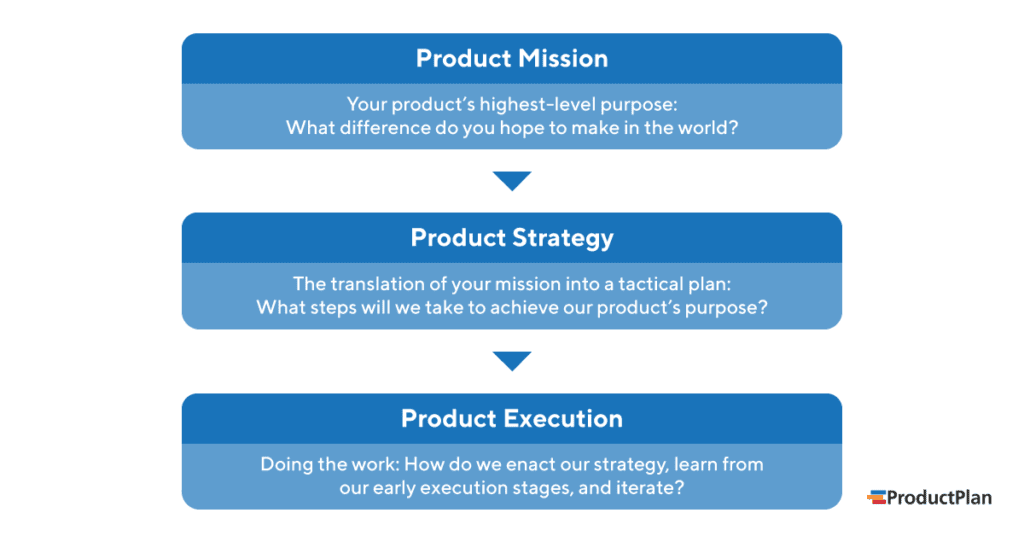You hear the term product strategy all the time, but what does it mean? What does an effective product strategy look like? How does it improve the odds of product success? This article gives you a step-by-step guide to building a killer product strategy framework.

Product Managers: Treat Your Strategy Like a Product
The Product Stack recently hosted a webinar on developing an effective product strategy. The panelists offered several ways of understanding what product strategy means and where it fits into the overall process of bringing products to the market. You can watch it for free below.
Hadrien Raffalli, product lead at VMware, offered this definition:
Product strategy is the art of finding and exploiting leverage in the competitive landscape to achieve the purpose you’ve set out for your product.
Hadrien also placed strategy in context as part of the broader product management process. First, you’ll establish your mission for the product. This is the highest-level objective or purpose—how your hope your product will change the world for the better. Hadrien pointed out that product teams and entrepreneurs often define their mission before understanding their market or user personas well. That’s okay. These learnings will come later.
Next comes the product strategy itself: finding something of value to your market that you can deliver to your competitors can’t or won’t.
Finally, Hadrien explained that after you’ve defined your product strategy, you will move on to execution, which he defined as the steps you’ll take to enact your strategy, learn from the early work your team does, and then course-correct accordingly.
An Example Product Strategy Framework
Kevin Steigerwald, Jama Software’s director of product design, offered concrete examples of the types of things that should comprise a product strategy. He used the following hypothetical:
Mission:
Become the #1 provider in this space
Strategy (just some of the items):
- Spend X% on marketing in this industry
- Build an appealing incentive structure for our sales reps
- Allocate X amount of resources and budget to develop this new product
Then, Kevin explained, you will create key performance indicators (KPIs) for each of these strategic elements to give your team a gauge of whether or not the company is executing successfully on the strategy.
Product Strategy Pro Tip
ProductPlan’s Annie Dunham added another contribution to the discussion on product strategy: It needs to be grounded in reality.
Strategy comes after the product team sets the product’s mission or purpose, and it borrows from the enthusiasm and ambition of the mission. That’s fine, Annie explained, but the product strategy needs to take a measurable and realistic approach. Only if you set quantifiable steps and goals in your product strategy will you be able to determine whether or not it’s working.
Download The Product Strategy Playbook ➜
10 Steps to a Killer Product Strategy Framework
Now let’s get into the details. How do you develop a product strategy using a framework, step by step? Here’s a summary of our webinar panelists.
Step 1: Create an ambitious product mission or vision.
As we’ve pointed out, your strategy should flow naturally from your product’s mission or vision. So, before you can start writing out the strategy, you need to develop your product vision: what you hope it will do to enhance your user persona’s life, add value to your market, or even change the world. Be bold, ambitious. Stretch. In other words, have a major purpose.
Step 2: Learn about customer needs and how they’re evolving.
As Hadrien explained, you can develop your product’s purpose before you get to know your user persona well. But to build an effective product strategy, you’ll need to truly understand your market—what your customers need, what they want, what problems they face, and are willing to pay to resolve, etc.
So, your next step should be to get to know these people. Do market research. Talk to your user personas. Develop a detailed profile on them and identify the challenges they face that your product could address.
Step 3: Understand where your product idea fits into the value chain.
Your product won’t exist in a vacuum. It will be part of the larger context of your users’ lives. You need to understand this larger context to know how your product fits in, and what if any obstacles your target customers might face using your product—even if they want to.
A great example of this is Netflix. The company successfully transitioned its business model from DVD rentals by mail to an online streaming service. But first, Netflix had to make sure its new model would work logistically, technologically, and financially for its customers and partners. Questions the company would’ve had to answer before making this transition included:
· Will the average consumer have enough bandwidth coming into their home to support streaming movies and TV shows? (If not, this might not work.)
· Will the internet providers continue charging by bandwidth, or will they move to a flat monthly rate? (If ISPs kept billing by bandwidth, this might not work.)
· Will some ISPs, whose bandwidth we’re consuming in large quantities, block our content off to protect their margins? (If that’s a possibility, this might not work.)
Step 4: Look for similar growth patterns and cycles in other markets.
You don’t need to start from scratch to build a product strategy. If you’re trying an innovation, maybe you can find an example of a product in another market that gained market share—and follow that product’s strategy. What did the company do to promote the new idea? What did their go-to-market strategy look like? Can you use some of the techniques of this other company to set the strategy for your product?
Also, can you find the stories of other companies that failed in that market? What techniques did they use that you’d want to avoid in your strategy?
Step 5: Identify the ways your market might change and be ready.
As you examine similar trends and patterns in other markets, you will get a better sense of how things can evolve. Also, if you’ve gotten to know your user personas, you might be able to make educated guesses about where things are headed in their markets or in the new tools and processes that they’ll be adopting soon.
Based on this knowledge, you’ll want to make educated guesses about these potential upcoming changes so that you can build your strategy accordingly.
Step 6: Develop your strategy’s KPIs.
As Annie pointed out in the webinar, your goal should be to develop measurable KPIs while you’re creating your strategy—not backfilling them after your strategy is complete.
The reason for this is that it will give you quantifiable ways to determine if you’re basing your product strategy on accurate assumptions or not. Discovering early on that your initial assumptions were flawed will allow your team to course correct sooner. It means less time spent going down the wrong path in your product’s development.
Step 7: Build your product roadmap.
Your product roadmap should always be tied to strategy. Every theme, epic, and other product initiatives your team are considering should earn a spot on the roadmap only to the extent that it supports your product strategy.
With this in mind, your roadmap should flow naturally out of the product strategy you’ve just developed, and you should make a point of including your strategic reasoning on the roadmap itself.
Download The Product Roadmap Strategy Playbook ➜
Step 8: Communicate your strategy.
With a completed version of your product roadmap, you’re ready to share your product strategy with all relevant stakeholders. Your roadmap should be the vehicle you use to convey your high-level plans and goals—your “why”—behind your strategy.
During our webinar, Kevin made a great suggestion for articulating your product strategy clearly and persuasively before introducing it to the whole company.
First, Kevin said, have an informal discussion with your manager and try explaining your strategy. Does your manager understand it and find it persuasive? If not, you’ll want to review it, check it for flaws, things that might be missing, or if you just haven’t fully grasped it yourself to articulate it clearly.
If your manager does find the strategy persuasive, that’s a win! Now, spread the word to all of your stakeholders—not only about strategy but also the vision as well. Remind your cross-functional team often of the big-picture mission you’re aiming for, and the specific strategy you’ve outlined to get the company to achieve that mission.
Bonus tip: Your roadmap should contain your strategic reasoning for every major theme or epic it contains. If you’ve prioritized building new functionality into the product, the roadmap should justify that decision—with a brief strategic explanation, a relevant piece of data, etc.
Step 9: Begin executing on your strategy.
Now it’s time for your team to translate the strategic steps into actionable tasks. This could include engaging your UX team to create mockups and your developers to create working prototypes of the product. Your goal should be to present a sneak peek of what the product will eventually do—and maybe even offer limited functionality—to your users, to gauge their interest levels, ideas, and other feedback. All of which will inform your next and final step.
Step 10: Measure your progress and course-correct along the way.
The more you can ground your product strategy in real data, the greater your chances for success in the market. With that in mind, you’ll want to make your product strategy a two-way conversation between your team and your users.
At every step in the product strategy framework, take the feedback you’re gaining from users and check it against your existing strategy. If your product is resonating with potential customers, then keep going. If users are sending you signals that they’d be more interested in different functionality or roadmap prioritization, then take this data and use it to find another way to achieve your product’s mission.




